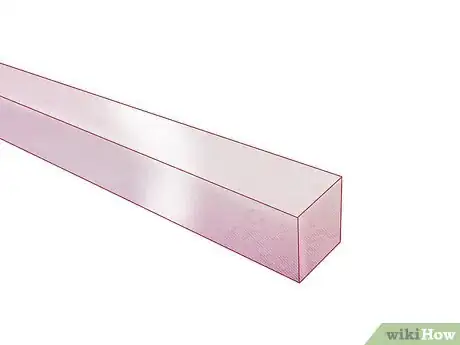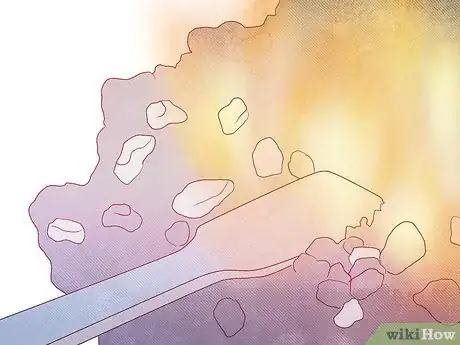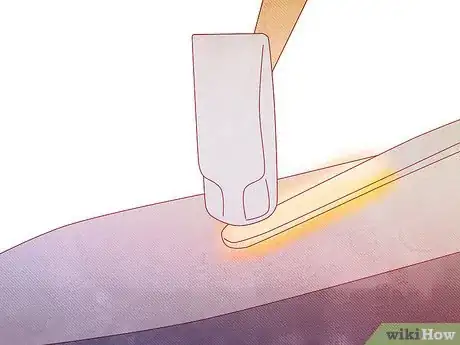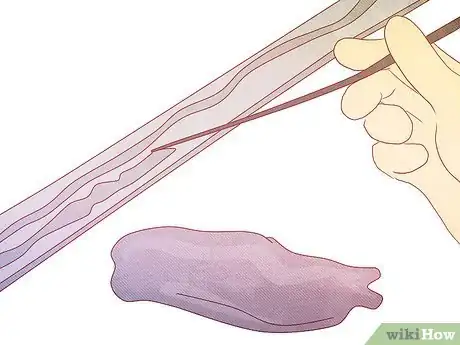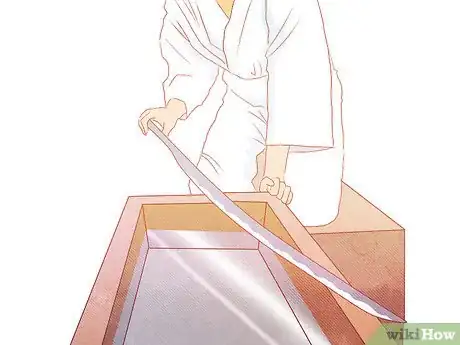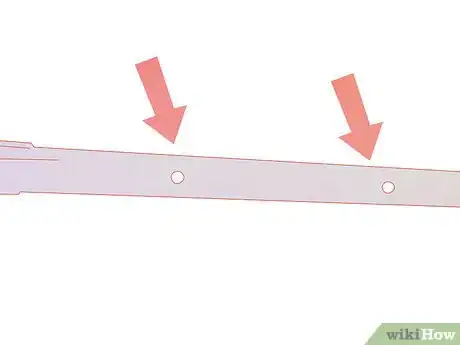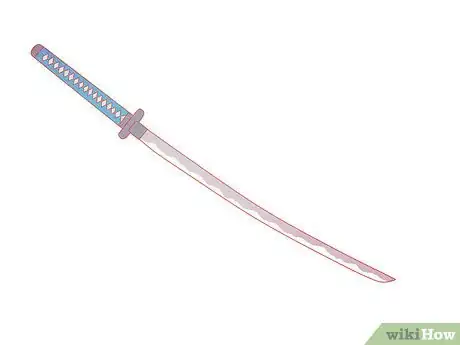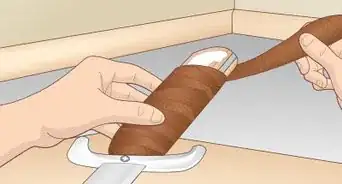X
wikiHow is a “wiki,” similar to Wikipedia, which means that many of our articles are co-written by multiple authors. To create this article, 28 people, some anonymous, worked to edit and improve it over time.
This article has been viewed 251,631 times.
Learn more...
A samurai sword, or katana, is a curved, single-edged sword first worn by Japanese warriors in the 13th century. By learning to make a samurai sword, you can create a formidable weapon or even use it as an impressive addition to your home's décor. Follow the steps below to forge your own samurai sword.
Steps
-
1Purchase or find a piece of steel about 2 inches (5.1 cm) wide and .5 inches (1.27 m) thick and slightly more than 3 feet (0.9 m) long (0.914 m).
-
2Heat the steel in a furnace or open hearth. You must heat the material to temperatures nearing 1,600 degrees F (870 degrees C) to make it malleable for forging and to remove impurities. During the heating process, substances like sulfur and silica will oxidize and separate from the iron, creating slag. The removal of slag greatly strengthens the steel.Advertisement
-
3Pull the heated material from the hearth when it becomes a yellow-orange hue and put it on an anvil.
-
4Forge the steel.[1]
- Strike the substance with a hammer, turning it as you forge. You will need to reheat the substance during the forging process to keep it malleable.
- Bend and chisel the substance on the anvil to form the blade shape. Target your hammer strikes to help shape the blade. Focus on the basic proportion of the blade initially.
- Forge the sword tip once you are satisfied with the basic blade shape, and then work on curvature and bevels. Bevel the blade in two sections: a long, sharp bevel extending to the tip of the sword provides the cutting edge of the sword and the shorter, thicker section runs along spine of the sword.
- Taper the blade on the end that will join with the handle.
-
5Shape the blade. Use grinders and files to form the final shape of the blade.
-
6Treat the blade with a special clay mixture.[2] You can add a mixture of clay and other substances, like grass and feathers, to the blade to achieve desired results. Coat the spine of the blade with the mixture, leaving the edge largely untreated. This will help make the spine flexible and the edge sharp. Reheat the blade in the forge.
-
7Quench the steel. This process both cools and hardens the substance.[3] You can use water or oil for quenching.
- Immerse the blade in water or oil along the edge and tip first. This method has a dual purpose: to make the cutting surface hardest and to keep the back of the blade softer to absorb blows meted out by adversaries. Quenching technique is important as the faster you quench the blade, the harder it becomes.
-
8Temper the blade. Reheat the blade to about 400 degrees F (204.4 degrees C) after quenching and then allow it to cool to room temperature. This process helps balance the blade's flexibility and hardness.
-
9Remove the clay mixture from the blade and grind the blade edge until it is sharp.
-
10Polish the blade. Use water stones to sharpen the blade. When polishing is complete, the hardened and unhardened portions of the blade will become apparent. Give the blade a final filing for cosmetic purposes.[4]
-
11Drill two holes at the base, or tang, of the blade to help fasten it to the hilt.
-
12Fabricate the handle.[5] The sword handle, or hilt, must be long enough to accommodate both hands and provide optimum balance when joined to the blade.
- Build the handle out of a hardwood, like yellow poplar or alder. Quarter-saw the wood at the end to provide maximum strength.
- Install two brass or copper pegs and anchors and align them with the tang. They will hold the blade in place.
-
13Secure the blade to the hilt. Insert the hilt pegs through the holes in the blade's tang and fasten them to their anchors. Use industrial adhesive and leather wraps to further strengthen the attachment of the blade and handle.
Advertisement
Community Q&A
-
QuestionWhat type of steel should I use for this katana Sword?
 Community AnswerYou need a steel with high carbon content. The most common ones used in swords are 1045, 1065, and 1095 carbon steels.
Community AnswerYou need a steel with high carbon content. The most common ones used in swords are 1045, 1065, and 1095 carbon steels. -
QuestionWhere do I find all these materials?
 Community AnswerYou can check Home Depot, Lowe's, and other lumber and metal supply places.
Community AnswerYou can check Home Depot, Lowe's, and other lumber and metal supply places. -
QuestionHow can I make the clay?
 Community AnswerThe good thing about modern technology is, you don't have to! You can just go to Home Depot and buy furnace cement or furnace clay. You can get a small container of it for around $8. If you can't find furnace clay/cement, use a mixture of 2 parts Plaster of Paris, 2 parts sand, and 1 part water. When you mix it up, it makes a great insulation. You might have to wait a few minutes for it to partially dry, but it works perfectly.
Community AnswerThe good thing about modern technology is, you don't have to! You can just go to Home Depot and buy furnace cement or furnace clay. You can get a small container of it for around $8. If you can't find furnace clay/cement, use a mixture of 2 parts Plaster of Paris, 2 parts sand, and 1 part water. When you mix it up, it makes a great insulation. You might have to wait a few minutes for it to partially dry, but it works perfectly.
Advertisement
Warnings
- Use high quality metal for the blade, such as steel.⧼thumbs_response⧽
- Make sure that your katana sword is made traditionally as modern katana swords lack forging process which is very essential for contributing in the quality of a sword.⧼thumbs_response⧽
- The steel gets very hot in the process of making the katana, so be careful not to burn yourself.⧼thumbs_response⧽
Advertisement
Things You'll Need
- A piece of steel about 2 inches (5.1 cm) wide and .5 inches thick (1.27 cm) and slightly more than 3 feet (0.9 m) long (0.914 m)
- Open-hearth furnace
- Anvil
- Hammer
- Chisel
- Grinders
- Files
- Clay mixture
- Quenching pool
- Water stones
- Metal drill
- Brass or copper pegs and washers
- 18 inch (45.72 cm) block hardwood for the sword handle
- Leather wraps
- Industrial adhesive
References
- ↑ https://www.bbc.co.uk/programmes/articles/VCSzzlnV0HbKDnmv9c0NFb/sacred-arts-how-to-make-a-japanese-samurai-sword
- ↑ http://www.samuraisword.com/REFERENCE/making/japanse_swordmaking_process.htm
- ↑ https://www.bbc.co.uk/programmes/articles/VCSzzlnV0HbKDnmv9c0NFb/sacred-arts-how-to-make-a-japanese-samurai-sword
- ↑ https://www.pbs.org/wgbh/nova/samurai/swor-nf.html
- ↑ https://www.pbs.org/wgbh/nova/samurai/swor-nf.html
- http://www.samuraisword.com/REFERENCE/making/japanse_swordmaking_process.htm
- http://www.quanonline.com/military/military_reference/japanese/history.html
About This Article
Advertisement
